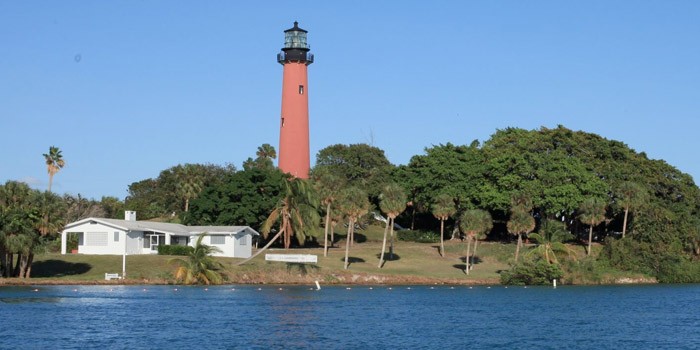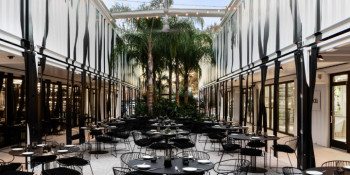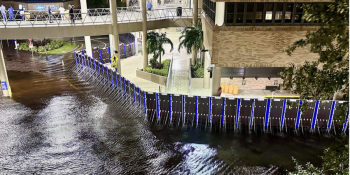The Jupiter Lighthouse

A Guide and History
Jupiter’s cylindrical tower and most famous landmark; the Jupiter Inlet Lighthouse is a beacon that shines brightly at night to illuminate the city and serves as a guide for numerous vessels traveling along Jupiter’s shores. The lighthouse is located on the north side of the Jupiter Inlet (anchor link) and it sits on a piece of land situated at the junction between the Jupiter Inlet and the Indian River. It is the only lighthouse along the east Florida coastline to be found between the Cape Canaveral and Hillsboro Inlet lighthouses and one of the oldest buildings in Palm Beach County.
Although the site for the Jupiter lighthouse was decided upon in 1853, the actual lighthouse was not fully constructed until 1860. This was due to building interruptions caused by the Third Seminole War. The design of the lighthouse came from Lieutenant George G. Meade of the Bureau of Topographical Engineers. This design was then slightly modified by Lieutenant William Reynolds, who succeeded Meade as head of the 4th and 7th Lighthouse Districts and improved the strength of the lighthouse with a double wall design and a First Order Fresnel Lens, the most powerful lens available. The lighthouse’s lens is actually thought to be the oldest First Order Fresnel Lens in Florida. Behind the lens sits the 1,000-watt, 120-volt GE quartz-iodine bulb lamp, which is socketed into a lamp changer with an identical spare. When in operation, the light is visible 24 miles out to sea and in an airplane, it is visible 40 to 50 miles away. Subsequently, the lighthouse and oil house construction was completed by Captain Edward Yorke on in May 1860. It was first lit July 10, 1860.
The Jupiter Lighthouse’s Daymark is red with a black lantern. This distinctive color combination allowed ships to determine that they were sailing past Jupiter, Florida during the daylight hours. During the night; however, the Lighthouse also needed a distinctive mark to alert sailors to their location. This is accomplished with the light itself. Just as each lighthouse is painted in distinctive colors and patterns, each flashes in distinctive sequences. The Jupiter Lighthouse flashes for 1.2 seconds, eclipses (or darkens) for 6.6 seconds, flashes for 1.2 seconds, eclipses for 21 seconds, and then repeats the cycle. It is important to note that the bulbs do not blink (the original oil lamps did not blink either). It is the rotation of the lens that causes the bursts of light to be perceived as flashes.
In 1936, the US navy acquired 8.4 acres of the lighthouse’s grounds from the US Government and established an Intelligence Listening Post and a Naval Radio Station on the site. This later became known as Station-J. Station-J was a secret operation base tasked with intercepting German U-boat radio messages, warning Allied ships, and helping US forces attack enemy vessels. Station-J was able to pinpoint the names and locations of the submarines and, in 1943, over 60 German submarines were destroyed on account of the efforts of the men of Station-J.
Today, by continuous support of the Loxahatchee River Historical Society (LRHS) – a nonprofit organization which was initially founded to preserve the Jupiter Inlet Lighthouse area's history – the lighthouse can be easily accessed with a visit to the now-in-place Jupiter Inlet Lighthouse and Museum. Proclaimed one of Jupiter’s greatest attractions, the Jupiter Inlet Lighthouse is an absolute must for visitors from near and far. It offers a complete history of the tower and full access to the grounds, not to mention daily tours that lead visitors up the tower’s 105 spiraling, cast-iron stairs to the top of the venerable lighthouse to come in close range of the optic and revel in arguably the best view of the city of Jupiter. Also on the grounds are a Seminole Chickee, in illustration of the relationship between the Seminoles and the early lighthouse keepers. Although the Keeper’s house is no longer standing, some of the outbuildings are, providing a sense of life at the lighthouse. This is also enhanced by the Tindall Pioneer House, which is the earliest house still in existence in Jupiter, affording a true glimpse of early life along the Loxahatchee. The last remaining Station-J building is to be found in the Museum itself, wherein visitors learn the history while actually walking among it. The Jupiter Inlet Lighthouse and Museum is open from 10 a.m. to 5 p.m., 7 days a week from May – December, and from Tuesday to Sunday from January – April.
The Jupiter Inlet Lighthouse and Museum is located in Lighthouse Park, 500 Captain Armour's Way, Jupiter, Florida.








